To sharpen your planetary photos, capture at high frame rates (50-100 fps), optimize frame selection using quality filters, apply wavelet processing in small increments, use Lucy-Richardson deconvolution for detail recovery, implement multi-point alignment during stacking, reduce noise selectively with masks, enhance contrast without clipping, employ channel-specific sharpening, maintain 16-bit files until final export, and balance sharpness with natural appearance. These techniques will transform your blurry planetary captures into crisp, detailed astronomical images worth showcasing.
10 Simple Techniques To Sharpen Planetary Photos

A blurry Mars or Jupiter can transform into a detailed masterpiece with the right sharpening approach.
When processing your planetary images, start by utilizing wavelet filters in RegiStax. These powerful tools let you adjust six precise sliders to enhance details while keeping noise under control.
RegiStax wavelet filters unlock planetary details with precision—six sliders that reveal cosmic clarity while taming visual noise.
For post-processing, Adobe’s Smart Sharpen with a 2.4-pixel radius and 13% amount offers excellent clarity without degrading your image quality.
Consider working in small incremental steps rather than one aggressive adjustment—stack images first, then apply multiple gentle sharpening passes followed by subtle Gaussian Blur.
For advanced detail recovery, try the Lucy-Richardson deconvolution with just two iterations.
Always work in 16-bit TIFF format during processing to preserve information, converting to JPEG only for your final presentation.
Mastering High Frame-Rate Capturing For Better Source Material
While processing techniques can enhance your planetary photos, the quality of your source material ultimately determines your final results. Aim for high frame rates between 50-100 fps during capture to maximize your stackable frames. Record approximately 90 seconds of video, especially for fast-moving objects like Jupiter.
| Frame Rate | Impact | Best For |
|---|---|---|
| 50-60 fps | Good detail | Poor seeing conditions |
| 70-80 fps | Better detail | Average seeing |
| 90-100 fps | Excellent detail | Excellent seeing |
| 100+ fps | Maximum detail | Perfect seeing |
Experiment with different Barlow magnifications while maintaining high frame rates. Monitor seeing conditions closely—they’ll dramatically affect your stacked image quality. Use SharpCap for capture and AutoStakkert for stacking the top 25%-40% of frames for good results without excessive noise.
Optimizing Frame Selection With Quality Filters

Harnessing histograms allows you to visually assess frame quality by identifying clusters of high-detail images versus those marred by atmospheric turbulence.
You’ll find seeing indicator metrics particularly valuable, as they provide numerical feedback on atmospheric stability during your imaging session, helping you select frames captured during moments of better seeing.
Eliminating defective frames through RegiStax’s Quality Estimate Methods guarantees your final planetary image contains only the sharpest data, greatly enhancing detail retention while keeping noise levels manageable.
Histograms for Frame Assessment
Because planetary imaging generates thousands of video frames, understanding how to evaluate their quality becomes essential to successful processing. Histograms serve as visual guides to assess brightness and contrast, helping you identify ideal frames for stacking. When examining your frames, look for histograms with well-distributed pixel values that avoid clipping at either end.
| Histogram Pattern | Indicates | Action Required |
|---|---|---|
| Centered peak | Good exposure | Prioritize for stacking |
| Left-skewed | Underexposed | Adjust exposure up |
| Right-skewed | Overexposed | Reduce exposure time |
| Evenly distributed | Balanced contrast | Excellent for stacking |
| Multiple peaks | Complex detail | Check for potential value |
Quality filters based on histogram data help you automatically exclude poorly exposed frames, ensuring only the sharpest, most balanced frames contribute to your final stacked image, dramatically improving detail and clarity.
Seeing Indicator Metrics
Since atmospheric turbulence constantly varies during your imaging session, not all captured frames will deliver equal quality.
Modern stacking software provides valuable seeing indicator metrics that help you identify your sharpest captures.
Use AutoStakkert’s quality graphs to select only the top percentage of frames based on sharpness and contrast metrics.
For ideal results, implement RegiStax’s Local Contrast and Gradient methods when evaluating frame quality during alignment.
Though 800-900 frames typically provides a good balance between detail and noise, always prioritize quality over quantity.
Adjust the Quality Cutoff and Difference Cutoff sliders to exclude poorly aligned frames that could degrade your final image.
Remember to monitor seeing conditions closely—capturing during moments of atmospheric stability will greatly increase the percentage of high-quality frames in your dataset, resulting in sharper planetary photos.
Defective Frame Elimination
Three critical steps separate average planetary images from exceptional ones, with defective frame elimination being perhaps the most decisive. You’ll need to implement quality filters that assess each frame’s sharpness before stacking. Software like RegiStax allows you to automatically rank and select only the best frames based on local contrast and gradient values.
| Quality Filter Type | Purpose | Ideal Setting | Result |
|---|---|---|---|
| Local Contrast | Measures detail | Medium-High | Sharper features |
| Gradient | Detects edges | Adjustable | Defined boundaries |
| Alignment Quality | Tracks registration | Average initial frame | Proper positioning |
| Frame Count | Balances detail/noise | 800-900 frames | Best SNR |
Instead of tediously sorting thousands of frames manually, let automated tools identify your sharpest captures. Stacking only the top 10-20% of frames will dramatically improve your final stacked image’s clarity and detail.
Leveraging Wavelet Processing For Enhanced Detail

Wavelet processing gives you unprecedented control over detail enhancement by letting you select specific frequency layers that correspond to different scales of features in your planetary photos.
When working with wavelets, you’ll find that higher-numbered layers address larger structures while the first layers target fine details, allowing you to extract subtle surface features while simultaneously denoising your image by selectively applying adjustments.
You can maximize detail extraction by gradually increasing the strength of each wavelet layer, paying careful attention to how noise levels respond to your adjustments across the different frequency bands.
Wavelet Layer Selection
The secret weapon in planetary imaging lies in RegiStax’s powerful wavelet processing capabilities. When selecting wavelet layers, you’ll need to strategically choose which frequency bands to enhance to sharpen the image without amplifying noise.
The six wavelet sliders control different spatial frequencies, with lower numbers affecting finer details. Start conservatively with the first two or three layers, gradually increasing values while monitoring for unwanted noise.
The Central number setting determines your highest frequency for sharpening—crucial for bringing out planetary features.
After stacking your ideal 800-900 frames, adjust the Quality Cutoff to exclude poorly aligned frames before applying your wavelet adjustments. This selective approach guarantees only quality data contributes to your final result, revealing delicate features while maintaining a natural appearance.
Denoising With Wavelets
While sharpening reveals critical planetary details, effective noise reduction remains equally important. Wavelet sharpening excels because it enhances details without amplifying background noise, greatly improving your images’ signal-to-noise ratio.
To effectively denoise while preserving fine details:
- Apply wavelet filters after stacking your images to capitalize on the already improved signal-to-noise ratio.
- Start with conservative settings on the six RegiStax sliders and increase gradually to avoid introducing artifacts.
- Use multiple wavelet layers strategically—lower numbers for fine details and higher numbers for larger features.
- Balance enhancement across different spatial frequencies to maintain a natural appearance while still bringing out subtle planetary features.
This selective approach lets you extract maximum detail while keeping noise under control, resulting in clearer, more accurate planetary photographs.
Fine Detail Extraction
Successfully extracting fine planetary details requires mastering multi-scale wavelet processing, a technique that reveals features invisible in raw captures.
When working with RegiStax, adjust the six wavelet layers strategically—start with the first layer targeting highest frequencies for critical detail enhancement while carefully managing noise.
For ideal results, experiment with Quality and Difference Cutoff sliders to exclude poorly aligned frames, ensuring only the best data contributes to your final image. This selective approach greatly improves your signal-to-noise ratio, making subtle surface features pop that would otherwise remain hidden.
Tailor your wavelet settings to accommodate different atmospheric conditions by adjusting each layer’s strength.
This customization allows you to emphasize specific planetary features while maintaining natural-looking results, effectively balancing sharpness against noise artifacts.
Applying Strategic Deconvolution Techniques
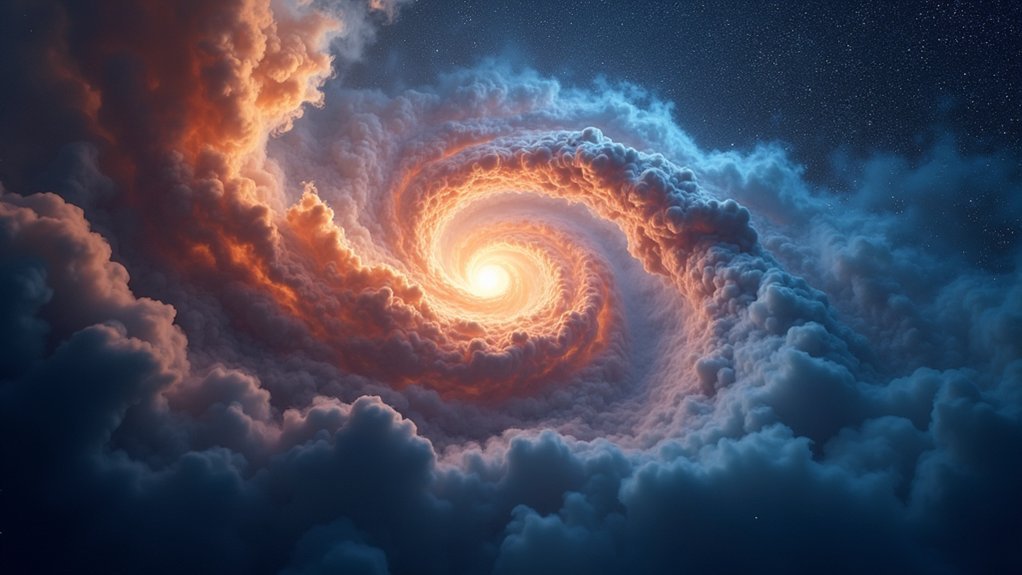
Mastering deconvolution techniques can transform your planetary images from good to exceptional. The Lucy-Richardson filter specifically excels at detail enhancement when you properly set the PSF radius.
Deconvolution transforms ordinary planetary shots into stunning revelations when you master the Lucy-Richardson filter’s subtle art.
You’ll need to experiment with this setting based on your specific image characteristics while carefully monitoring edge artifacts that can detract from natural appearance.
For ideal results with deconvolution:
- Start with two iterations – this balances detail recovery while keeping noise under control.
- Adjust the PSF radius manually for each image rather than using default settings.
- Integrate deconvolution into software like MaxIm DL or Lynkeos for more processing control.
- Monitor edges carefully during processing to prevent artificial-looking boundaries.
Don’t be afraid to experiment with different parameters – your willingness to fine-tune these settings will ultimately determine the quality of your planetary photographs.
Fine-Tuning Color Balance Without Detail Loss
Once you’ve sharpened your planetary images with deconvolution, preserving that newfound detail during color enhancement becomes your next challenge. Instead of reaching for the Hue/Saturation tool, use Photoshop’s Match Color function for superior results. This approach maintains image integrity while allowing precise saturation control.
Create separate adjustment layers for your color work, which enables you to fine-tune red-green and red-blue contrast independently. This layered approach gives you the freedom to adjust opacity, effectively controlling how intensely your color changes affect the final image.
For maximum detail preservation, try converting your sharpened image to monochrome before blending it with your color version. This technique guarantees your luminosity adjustments don’t sacrifice the fine details you’ve worked so hard to recover.
Using Multi-Point Alignment For Precise Stacking

While single-point alignment may suffice for basic planetary imaging, multi-point alignment dramatically elevates your stacking results by addressing planetary rotation and atmospheric distortion simultaneously.
When implementing this technique in your stacking process, focus on these critical steps:
- Select an average quality frame as your reference point, avoiding unusually sharp or blurry frames that might skew alignment.
- Distribute multiple alignment points strategically across your planetary target, particularly near high-contrast features.
- Adjust your alignment box size based on current seeing conditions and the specific features you’re targeting.
- Experiment with different quality estimate methods like Local Contrast or Gradient to optimize the registration process.
The FFT Spectrum analysis can further refine your alignment’s precision by analyzing frequency data, ensuring superior detail retention in your final image.
Implementing Effective Noise Reduction While Preserving Features
You’ll need to balance noise reduction with detail preservation through selective masking strategies, targeting different areas of your planetary images with appropriate intensity levels.
Wavelets offer superior control compared to Gaussian filters when dealing with planetary features of varying spatial frequencies, allowing you to enhance fine details while suppressing noise in specific frequency bands.
Make certain you complete your frame stacking process before applying any denoising techniques, as this naturally reduces random noise and provides a cleaner starting point for your sharpening workflow.
Selective Masking Strategies
When processing planetary images, selective masking emerges as a vital technique that allows astrophotographers to target noise reduction precisely where it’s needed most. By isolating specific areas, you’ll preserve essential details while eliminating unwanted noise.
To effectively implement selective masking and sharpen edges in your planetary photography:
- Create a monochrome version of your image as a control layer to identify noise-prone areas without affecting color balance.
- Apply the High Pass filter to enhance edge details while selectively masking out noisy regions.
- Utilize layer masks in software like Photoshop to make precise adjustments to contrast and sharpness.
- Combine selective masking with Gaussian Blur in targeted areas to enhance image clarity while maintaining the integrity of delicate planetary features.
Wavelets vs. Gaussian
Building on our masking techniques, let’s examine two powerful noise reduction approaches that every planetary photographer should understand.
Wavelet filters, featured in RegiStax, offer precise multi-scale sharpening by targeting specific frequency layers. You’ll enhance fine details while minimizing noise by adjusting individual frequency sliders—particularly the central number. This gives you remarkable control over detail enhancement without introducing unwanted artifacts.
Complement your wavelet processing with Gaussian blurring (typically at 0.7-pixel radius) to smooth residual noise after sharpening. This combination creates a balanced workflow where you can gradually increase detail without noise overwhelming your image.
The key advantage? You’re targeting adjustments to different spatial frequencies, enhancing lower-frequency details while protecting higher frequencies from noise amplification.
Regularly monitor your adjustments, finding the sweet spot between crisp details and clean backgrounds.
Stacking Before Denoising
Before diving into advanced denoising techniques, mastering the stacking process creates the foundation for exceptional planetary images. Your success hinges on selecting only the sharpest frames, as poor-quality images will compromise overall image quality regardless of denoising efforts.
For best results:
- Stack hundreds or thousands of webcam images to dramatically enhance signal-to-noise ratio while revealing subtle planetary details.
- Use automated sorting programs to efficiently select your best frames, eliminating blurry ones that would introduce artifacts.
- Apply wavelet filters in RegiStax after stacking to sharpen details while controlling noise.
- Implement final denoising techniques like Gaussian Blur only after sharpening to reduce residual noise while preserving critical features.
This stacking-first approach guarantees you’re not just removing noise but building detail-rich images from the start.
Balancing Contrast Enhancement Without Artifacts
Achieving the perfect balance between sharpness and natural appearance represents one of the most challenging aspects of planetary photography processing.
The delicate dance between clarity and authenticity remains the ultimate challenge in planetary image refinement.
When adjusting image scale, you’ll need to carefully monitor your histogram to prevent clipping while enhancing brightness and contrast.
Apply Adobe’s Smart Sharpen tool with a radius of 2.4 pixels at 13%, then follow with a subtle Gaussian Blur (0.7 pixel radius) to control how noise becomes visible.
For precise adjustments, use curves layers rather than direct adjustments. This approach gives you greater control over tonal ranges without introducing artifacts.
For color enhancement, utilize tools like ‘Match Color’ to improve vibrancy while maintaining a natural appearance.
Save your work as 16-bit TIFF files during processing, only converting to 8-bit JPEG after completing all adjustments to preserve maximum detail.
Employing Channel-Specific Sharpening Methods
Channel-specific sharpening offers a powerful advancement over general image sharpening techniques, giving you granular control over detail enhancement in planetary photography. The red channel particularly excels at revealing subtle details like dust lanes, making it your priority target for enhancement.
Try these channel-specific sharpening methods to elevate your planetary images:
- Apply unsharp masking to individual color channels, using a radius of 2.4 pixels and 13% amount to sharpen details while minimizing noise.
- Create separate layers for color balance adjustments, allowing precision control over each channel’s luminosity.
- Implement a high-pass filter on the luminosity layer to enhance contrast without affecting color integrity.
- Utilize Lucy-Richardson deconvolution on separate channels with careful PSF radius settings to refine details and reduce noise.
Frequently Asked Questions
How to Take High Quality Photos of Planets?
You’ll need a planetary camera with short exposures, properly collimated telescope, Barlow lens, and good seeing conditions. Capture thousands of frames, then stack and sharpen them with specialized software for best results.
What Is the Best Setup for Planetary Photography?
For the best planetary photography setup, you’ll need a 90mm+ telescope, 2x Barlow lens, high-speed camera (ASI-120/485MC), EQ mount, and proper collimation. Capture 50-100fps video for 90 seconds to maximize usable frames.
What Is the Best Aperture for Planetary Photography?
For planetary photography, you’ll want an aperture of at least 4 inches (100mm), but 8 inches (200mm) is ideal. Aim for f/10 to f/15 ratio to capture fine details while matching your local atmospheric conditions.
What Focal Length Is Needed for Planetary Imaging?
For planetary imaging, you’ll need at least 800mm focal length to capture good detail. You can use a Barlow lens to double or triple your focal length, achieving better magnification without a larger telescope.
In Summary
You’ve now got a complete toolkit for dramatically improving your planetary images. By combining high frame-rate capture, selective stacking, and advanced processing techniques, you’ll reveal details you never thought possible. Don’t be afraid to experiment with these methods—your skill will grow with each image. The planets are waiting to share their secrets, and you’re ready to capture them like never before.
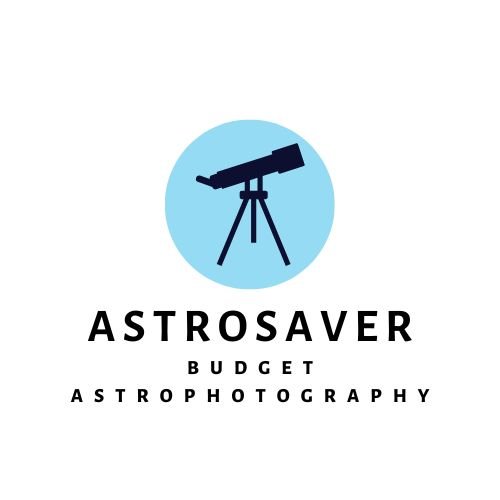

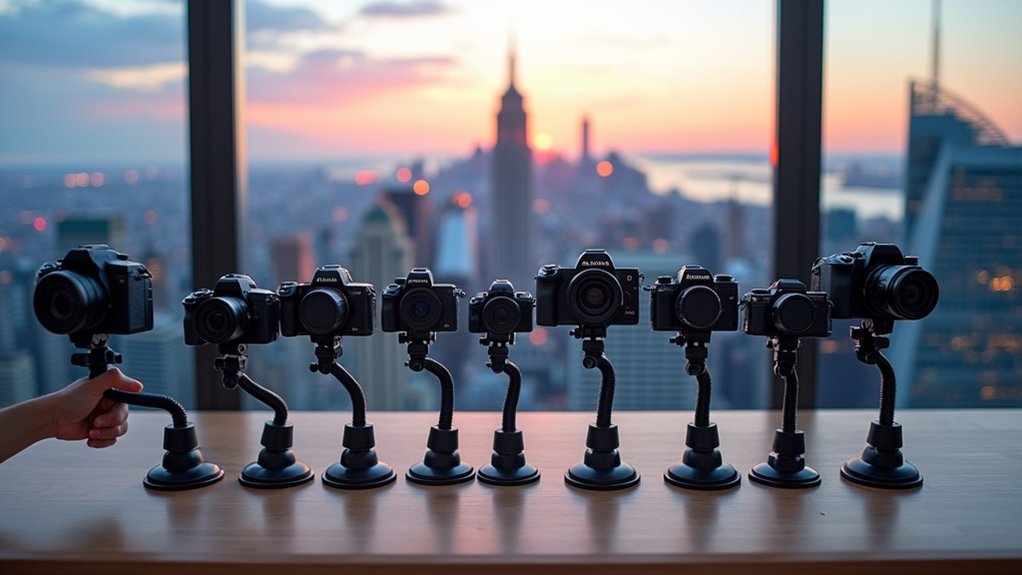
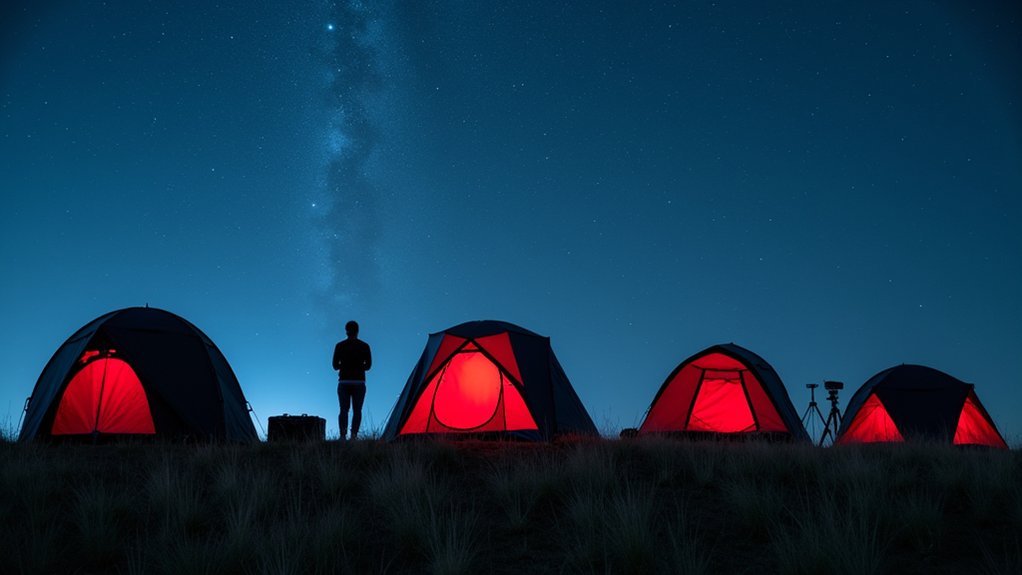
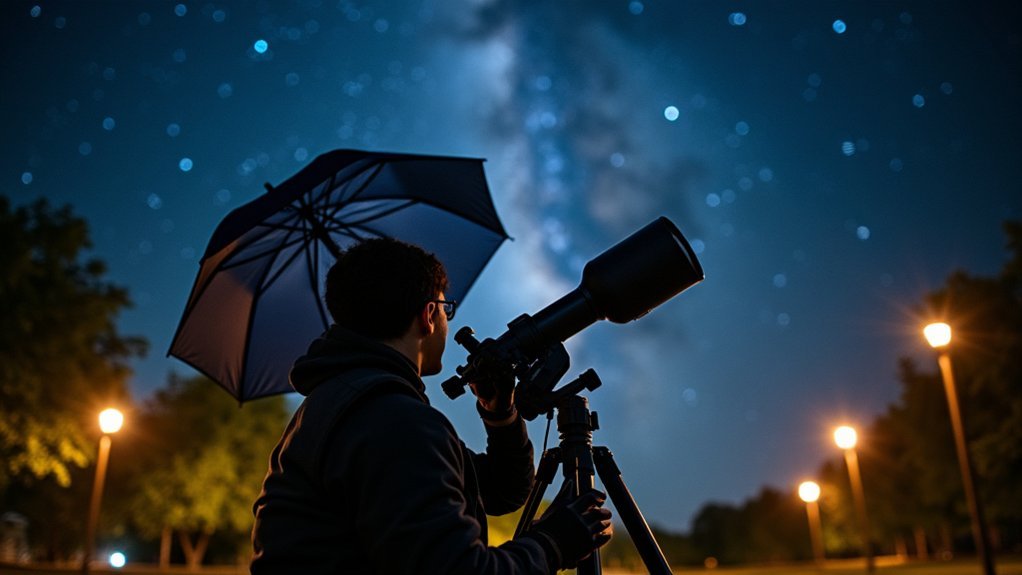
Leave a Reply